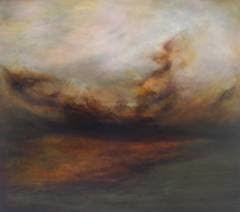 James Kennedy: Burning the Chafe, 48 x 52 inches, Oil on birch
James Kennedy: Burning the Chafe, 48 x 52 inches, Oil on birch PRESS FOR JANE MARTIN
By Eric Ernst
Publication: The East Hampton Press & The Southampton Press
Dec 15, 08 3:11 PM
In her current exhibition (it is now closed) at Guild Hall in East Hampton, “Reckoning and Rapture,” Jane Martin is showing works conjuring intriguingly ambiguous narratives brimming with sensuality and an understated yet powerfully emotional psychological tension.
The exhibition is particularly interesting in its demonstration that these effects are perceived less by the viewer’s eyes and more through the emotions, reflecting, as the Swiss psychiatrist Carl Jung once wrote, that one should never “pretend to understand the world only by the intellect, we apprehend it just as much by feeling.”
This has been an ongoing theme in Ms. Martin’s work over the last few years, most powerfully in the images from her series of video stills in the “Closer Far Away” series, featuring swaying nude female forms dancing to unheard yet delicately insistent rhythms. Allowing the figuration to take on mysterious qualities of apparitional wood nymphs furtively darting in and out of mystifying banks of fog in a primeval forest, the works juxtapose a certain surreal and dreamlike ambiance with the implied rationale and immediate impact of photographic reality.
Creating an environment in which madness and sanity are interchangeable emotional components, these works construct an intriguingly vague story line that is a product of the cadences and melodies elicited more by what was partially hidden than what was immediately visible. These words could apply directly to the work of David Mitchell.
In “Shelter-Sky” (video still, archival pigment print, resin, mixed media on wood, 2005), for example, the figure is frozen in motion, the strange intensity of the forest scene accentuated by the thick banks of fog from which the figure materializes. This effect is also heightened by the layers of resin that are poured over the photographic image, the elegant sheen invoking a great sense of depth while further underscoring a sensation of ambiguity and emotional distance that is powerfully arresting.
This construct is also prevalent in some of Ms. Martin’s more recent works, such as “On Wings, Lifted II” (video still, archival pigment print, resin, mixed media on wood, 2008) and “Reckoning” (digital C-print mounted on Dibond, 2008), each of which immediately establishes ineffable psychological overtones with the figuration of dancers frozen in motion, moving to what seems to be a cacophonous harmony that is silently dissonant and expressively jarring. Embodying a profound combination of mystery and sensuality, they illustrate the essayist Havelock Ellis’s observation that dance “is no mere translation or abstraction from life, it is life itself.” Interestingly, this existential narrative, which initially seemed a product of the ambiguity of the figures themselves as unrecognizably hazy seraphs, gains even more impact in the recent works in which Ms. Martin focuses on fragments of images that she then configures and constructs into a kind of psychological portraiture.
In works such as the two triptychs, “Immersion #1” and “Immersion #2” (both Digital C-Print, gallery mount on Sintra, 2008), for example, while posture and pose are still important elements in the compositions, the action derived from motion becomes more reminiscent of a stop-action sequence than of a single cell from which one discerns the artist’s thematic concept. In addition, and perhaps most important, while the figures are partially obscured by steam and condensation, Ms. Martin makes the personas of the models a more immediate element. This is accomplished through a narrative derived from stringing together shards of a given instant, thereby creating a disjointed portrait of a moment in time, a stream of consciousness that is somehow simultaneously openly revealing and opaquely vague.
This dichotomy reaches an apogee of sorts in the nine-panel “Inward Appearances” (video stills, archival pigment prints, resin, mixed media on wood panels, 2008) in which the grid of abstracted photographs offers a psychological narrative that is contemplatively disrupted, like fragments of memories that may pertain to a specific moment, even though their meaning changes depending on the order in which one confronts them.
This same effect is also a factor in Ms. Martin’s series in which the human form is replaced by images of waves, the differences in configuration of each swell managing to tie them together as pieces of an ever changing plot that one understands as much through their relationship to abstract imagery as to representational reality.
________________
Detail (section) from my latest Topographic Tiling Series of 12x12 inch pieces are intended to wall mount intuitively in accordance with the particular environment.
Lynn Dunham: Topographic Tiling Segment 2008, 12 x 12 inches poly-eurathane foam, latex, acrylic and ink 

 David M. Mitchell: Thursday
David M. Mitchell: Thursday I was in Philadelphia this weekend and
I was in Philadelphia this weekend and David M. Mitchell: Archaeopteryx
David M. Mitchell: Archaeopteryx David M. Mitchell: Fate
David M. Mitchell: Fate Jane Martin: Shelter-Sky
Jane Martin: Shelter-Sky David M. Mitchell: Numinous C print available in limited edition of varied sizes.
David M. Mitchell: Numinous C print available in limited edition of varied sizes.